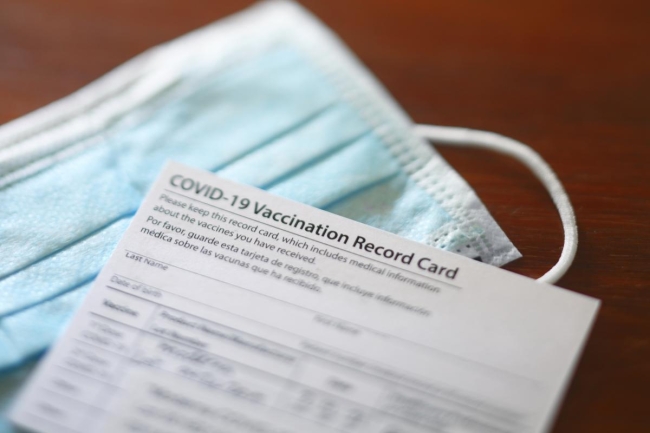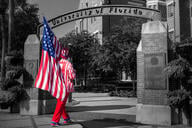You have /5 articles left.
Sign up for a free account or log in.

DNY59/iStock/Getty Images Plus
Faculty and staff members reported stark differences in their colleges’ fall semester COVID-19 protocols and plans across institutions and geographic regions, according to a new national survey.
Sixty-five percent of respondents said their institutions planned to open for normal in-person classes, while 31 percent said their campuses would offer a mix of in-person and online instruction, the August survey by the admissions management company Liaison International found.
While the numbers of colleges with vaccine and mask requirements have likely increased since the survey closed Aug. 20, fewer than half (48 percent) of the approximately 900 survey respondents said their colleges were requiring vaccination for students, and 43 percent said their institutions were requiring vaccination for students and employees. Slightly more than two-thirds (68 percent) said their institutions were mandating masks.
There were significant differences in safety measures across regions. Just 53 percent of survey respondents from the South indicated their colleges had a mask mandate, compared to 73 percent of respondents from the Midwest and Northeast, respectively, and 84 percent from the West.
A quarter of respondents from the South said their institutions were requiring vaccines for staff members, compared to 37 percent in the Midwest, 58 percent in the Northeast and 70 percent in the West.
“Regional differences are driving COVID-19 policies on reopening, masks, and vaccines,” a report on the survey says. “Institutions in the South, faculty and staff reported, are far more likely to reopen and hold in-person classes, while colleges and universities in the Northeast were the least likely to be open to students. Colleges and universities in the South and Midwest are less likely to require vaccines for faculty, staff or students, while institutions in the Western United States are more likely to ask faculty and staff members to vaccinate.”
Bryan Alexander, a senior scholar at Georgetown University who has tracked colleges’ responses to COVID, said, “It’s grim that some of the schools most likely to go [face-to-face] are the ones in COVID hot zones -- i.e., those in the South.”
Some Republican-led states in the South or Midwest have restricted colleges’ ability to require vaccination or mask wearing. The American College Health Association has condemned such restrictions, saying they undermine the ability of colleges to operate safely “and ultimately threaten the health and safety of students, faculty, staff, and neighboring communities.”
The Chronicle of Higher Education has identified more than 1,000 colleges that are requiring vaccination for students or employees, a number that jumped by about 300 after the U.S. Food and Drug Administration granted full approval to the Pfizer vaccine Aug. 23, three days after the Liaison International survey window closed. The vaccine was previously approved through the FDA’s emergency use authorization process.
Provisional data collected in July by the College Crisis Initiative, a research initiative studying colleges’ responses to COVID at Davidson College in North Carolina -- prior to the full approval of the Pfizer vaccine -- found that 42.7 percent of colleges at that point encouraged but did not incentivize students to get vaccinated, 24.7 percent required students to be vaccinated and 4.5 percent incentivized students to get vaccinated. Another 17.6 percent of the 2,439 institutions analyzed did not have any relevant information on their website, and 10.5 percent did not require, incentivize or encourage student vaccination.
Whether or not their colleges are requiring the vaccine, 71 percent of respondents to the Liaison survey in August said their institutions are tracking the vaccination status of their students.
Gerri Taylor, co-chair of ACHA’s COVID-19 task force, said she expected President Biden’s newly announced plan to increase COVID vaccinations through employer mandates, which will be helpful in increasing vaccination rates on college campuses.
“We know that masks work,” she said. “If people would just wear masks, stay outside, use ventilation, open windows, distance themselves from others, those things would help tremendously. But having more people vaccinated will also help tremendously. If we can get all of that in place for the fall semester, I think we’ll be in much better shape, but that remains to be seen.”
Taylor said she hoped colleges that are tracking vaccination rates are also tracking case numbers and have plans in place to pivot to online instruction if needed, as a small number of colleges and universities already have this fall.
The Liaison International survey found that professors and staff feel prepared to return to remote learning if needed. Seventy-one percent of faculty or staff said they are extremely or very confident in their ability to adjust to a shift to online learning, and 92 percent felt confident that students are well prepared for such a shift.
“That’s a complete difference, 180 degrees from the last year,” said Joshua Schwartz, co-author of the survey report, the director of product marketing at Liaison International and an adjunct professor teaching business communications at Montgomery County Community College. “This year faculty are better prepared, even though they’re still concerned about the overall success for the students.”
Survey respondents cited the fear of being fully online as the top challenge students are facing this fall, followed by financial barriers to paying for courses due to COVID-19 impacts.
David Joyner, executive director of online education for Georgia Tech’s College of Computing, said he is not surprised faculty reported confidence about teaching online.
“My perception has been that a lot of people were initially nervous about it but very quickly found out how similar it could be and quickly found out some things that could be advantageous about it -- what was originally viewed as a last-resort thing now a lot of people see an advantage of it,” Joyner said. “My hopes are that we find ways to keep the best of both worlds going forward.”




